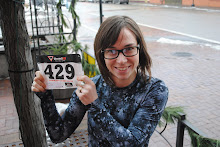Start reading different kinds of books.
It was last year in my Major British Writers class that I realized I hadn't read anything "just for fun" in quite some time. Required readings for class, which included epics like Beowulf and Paradise Lost, were quite the lofty reads (can you say allegory?). These particular pieces, combined with work from other classes left me with a pretty big work load. I certainly had no time to sit down and read books like War and Peace, and The Count of Monte Cristo just for the hell of it.
While working my new job at the library, my habit of sticking to this one genre also left me wondering what the books on my shelving cart were about, or who certain authors even were. My friends and co-workers would often mention really good books they've read that I would have never even considered reading. I was beginning to find out that I had boxed myself into a literary ignorance, and so I figured it was in my best interest (to use the ol' cliche) to expand my horizons.
There's nothing wrong with finding what's good or what works, and sticking to it. That's how I usually tend to do things. But if there's one piece of advice that I could give to anyone it would be to step outside that norm every once in a while.
You might be surprised.
I was.
The basis of my promise was to remember books that others had recommended to me, and actually try to read them. That's where this book comes in. My first experience stepping outside the world of classic fiction in probably years, I picked up the book The Girls Guide to Hunting and Fishing. I chose this book for two reasons: One, it seems to be directed more towards a female audience, which is something I certainly tend to steer away from, (forgive me, but I'm not the Brigit Jones's Diary or Nicholas Sparks type). Secondly, it was something a friend recommended to me a while ago that I just sort of politely agreed to "try to get around to reading", and immediately brushed off. I had forgotten about it until recently when I found it on the shelf at the library during work.

The Girl's Guide to Hunting and Fishing by Melissa Bank was surprisingly good. It's a coming of age novel where the young heroine, Jane Rosenal, winds her way through the many struggles of love, relationships, and work.
Now you're asking, So? It sounds like every other coming of age novel about a young girl. What's so great about it?
Well, hold on a bit longer. This book has an interesting little twist to it.
In many ways the book is like a modernized version of Betty Smith's novel A Tree Grows In Brooklyn. It's the story of a young girl born with a romantic nature, and a hunger for beauty and truth, who learns to survive the struggles of life. Both are well written from the point of view of their heroins. However, here's what separates the stories.
Unlike the narrator of A Tree Grows In Brooklyn, The author of The Girls Guide To Hunting and Fishing uses a writing style where it almost seems as if her narrator, Jane, is speaking out loud, like a transcription of her telling the story to another person. This perspective allows the lay out of events to be presented through a teenager's frame of reference that gives the narrative an ingenious kick. Brilliant and humorous, Jane provides readers with a dish of wit when necessary, and even when unnecessary. It's hard not to compare her uncanny first person point of view with that of Holden Caulfiled from J.D. Salinger's Catcher in the Rye. This book gives the traditional classic fiction coming of age novel a lively, new spin that makes it clever and incredibly fun to read.
To sum it all up in one sentence,
This book is one part A Tree Grows in Brooklyn, and two parts The Catcher in the Rye.

No comments:
Post a Comment